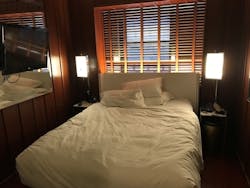I love boutique hotels and until this week, I was an advocate for the tiny room movement we’re seeing in hospitality. But this particular tiny hotel room drew big opinions from me.
I’ll put this out on the table: I’m a Millennial; a member of the generational group born between 1981 and 1996 (in 2018, millennials are between the ages of 37 and 22).
I didn’t grow up with the internet, but I adapted to it quickly. I got my first laptop after college, and in the decade-plus since then, I’ve gotten used to working from anywhere, which is a necessity for me since I travel for work several times a month. I’m also 5’3” when I’m trying, and I pack as minimally as possible. For this work trip to New York for six days, I have a backpack and a purse.
I don’t need a lot of room, so staying in a tiny room makes sense for me. I love seeing the innovation of how interior designers make the hospitality experience work in confined spaces. Give me a place to plug in my phone and computer, and a place to sleep (sometimes the same place) and I’m golden. Or, so I thought.
Because New York real estate is particularly expensive, it makes sense for hotels to think big by going small, and therefore pack more (and smaller) rooms into a property. However, from poor lighting to intrusive noise-levels to inadequate surface materials and more, not all travelers necessarily agree that the comfort level of micro-hotels equals that of traditionally-sized rooms.
Here are the many mistakes this tiny hotel room had:
Lighting
Hotels are tricky spots because they’re high-traffic, and you never know the purpose of someone’s stay. Lighting, for example, needs to set a mood, give the room personality, have enough lumens to allow the professional traveler to get work done, be UL-certified, and easily accessible from both the entry and the bed.
Personally, my favorite experiences have allowed me to turn on and off the room’s lighting from both the door and the bed. Staying in a new place can be off-putting as it is, but when you need to stumble through the dark to turn on or off the lights, it’s not an ideal experience.
On topic: Human-Centric Approach to Lighting
However, the most important aspect of lighting from a guest perspective is that it is easily understandable. The first few moments in a room should be spent enjoying the space and feeling as if first impressions were ideal rather than attempting to find the light switch.
Plug ins
At this point, I basically believe it’s a given that a plug or USB port will be made available on whatever surface is closest to the bed. If one isn’t immediately apparent, I will search the lighting for hidden ports.
It may not be a statistic people like, but 71 percent of millennials sleep with their phone either in bed with them or on the nightstand. A majority of people also charge their phones at night. When a plug isn’t available within arm’s reach of the bed, or if I need to go searching (or worse: unplug something in the room to make space for my phone charger), it’s a frustrating experience.
Looking for interesting options? Check out these rising plug trends.
If a guest can’t find the light switch or a plug both in the same stay, the experience has already lost a star in the guest’s rating.
Bathroom Layout
As I mentioned above: I’m short. My height is below-average for American women by several inches. I’m not someone who needs a lot of leg space, and I can feel comfortable even in the most low-budget plane seat.
Hotel bathrooms are tricky, but even in a tiny room they shouldn’t be an afterthought. Personally, I’m more understanding if the sink is outside the bathroom (as I have seen over and over again in small rooms) than if the space between the toilet and the wall is too close to accommodate things like knees.
Another aspect that can hinder the guest experience: what material the vanity is made of. In small spaces, thin metal makes sense because it doesn’t have the same type of weight that can make a space feel cramped. However, metal conducts heat, which is a byproduct of hair-styling tools.
Related: Is your emergency and exit lighting clearly marked?
The last thing anyone needs is a lawsuit because a guest was burned when the surface became hot-to-the-touch while they were getting ready.
Anything that Could Happen, Will
One of my favorite statements from a designer came during a panel discussion on hospitality design when it was mentioned that one needs to design for the idea that anything that could happen in a hotel will happen.
In tiny hotel rooms, that should be emphasized.
Engineering Necessities
Oftentimes, interior designers don’t have control over things like heating and air conditioning units and where they will be placed, but when it is your design, someone else’s problem becomes a factor that can change people’s opinions of your work.
One of the most obvious problems with my room this week was apparent the moment I walked into the bedroom. It’s one of those hot, muggy days in NYC where you never quite feel cool, dry, and comfortable, and that included in the hotel room. The wood floors and walls are sealed and don’t draw in any moisture—great for upkeep and potential mildew problems; terrible for guests who don’t want to feel like they’re getting wetter the longer they dry off from the shower.
The room is hot and wet. As someone who prefers heat and often keeps the thermostat at 74, I didn’t think that was an issue. Until it was.
It needs to be understood how placement of heating and air units will change the user’s experience.
Acoustics
As interiors + sources contributor Hanson Hsu has explained, acoustics in hotels is important; maybe doubly so if you’re in a small room.
I haven’t heard any of my neighbors with the exception of a few rowdy partiers around 3 a.m. while they attempted to get to their room. But I sure know when they’re up and getting ready, because the pipes in the walls have been screeching for well over 14 hours at this point. (My attempts to get someone to respond at the front desk were not being heard, the irony as thick as the air was in my room.)
Seriously. What would you do to get this noise to stop? (Press “play”.)
Again, the engineering issues are often out of interior designers’ control, but an interrupted experience comes from much more than just late-night revelers and material choices are important.
Hotels live and die by the reviews; skimping on acoustically-rated materials isn’t worth an angry guest who couldn’t sleep because their neighbor liked taking late-night showers or grabbed a glass of water when they were trying to work.
Two hand-picked articles to read next:
About the Author

Kadie Yale
Former Architecture & Design Expert
Kadie Yale holds a BA in Industrial Design from San Francisco State University and MA in Decorative Art History and Theory from Parsons the New School.
